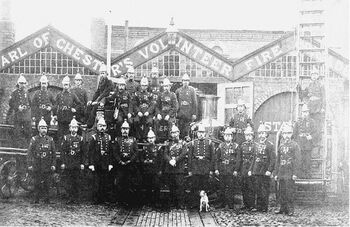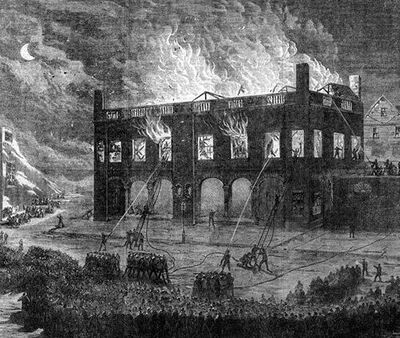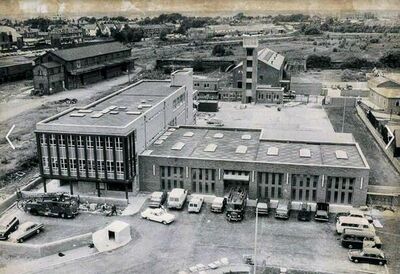Fire Station
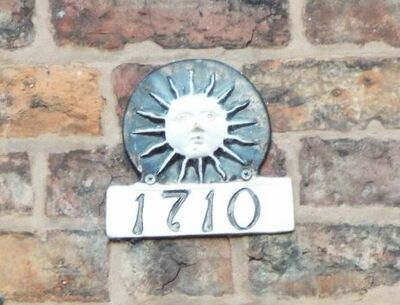
History of the Fire Service
The Chester "watch" of the middle ages still exists in the "watches" of the fire service. Even in mediaeval times prevention was thought better than a call-out and from the late 16th century to the 18th the 'constables' of each ward (see: Police) made monthly (occasionally fortnightly or weekly) reports to the Assembly on the numbers and lodging places of the unemployed poor and beggars, often also reporting on fire hazards and nuisances. From 1591 they were responsible for storing fire buckets, and from 1709 had oversight of fire-fighting. The Assembly provided fire buckets in 1570, and "a hook and a ladder" for each ward in 1591, to be maintained by the constables. From 1599 to 1633 or later strangers obtaining the freedom of the City had to provide two buckets. In 1671 thatching was banned as a fire precaution from the roofs of houses in the four main intramural streets and Foregate Street.
The use of the buckets and ladders is obvious. The hooks, a long pole with a hook on the end, was used to pull burning material from buildings and occasionally to salvage valuables. The city's fire-fighting equipment was still limited to these same buckets, ladders, and hooks in 1695, but the new waterworks inaugurated the previous year made more effective methods feasible. The city probably bought its first "fire engine" in 1705, and in 1709 issued a comprehensive set of fire regulations, which included the following:
- No person shall have or keep any more or greater quantity than two pounds of Gunpowder at any one tyme in any shop, sellar or lower room within this city except such Gunpowder and shall be kept in any carriers warehouse or shall be brought into this city to be exported into Ireland not being kept more than forty eight hours in such warehouse.

In 1709 the Assembly also built a fire-engine house abutting the bishop's palace and not far from the waterworks company's cistern in Northgate Street. "Ornamented with Corinthian pilasters and battlements", it was paid for by James Butler, 2nd duke of Ormonde. Hanshall describes it as follows:
- THE ENGINE HOUSE This is a neat building opposite the east side of the Exchange. It was erected about the year 1680 by the Duke of Ormond when Lord Lieutenant of Ireland but why this mark of respect to the City was manifested remains a secret. It is built of brick with stone facings ornamented with fluted Corinthian pilasters. An iron railing was placed round it in 1812 and the brick work coated with Roman cement. The Fire Engines are kept here and the City weights measures etc.
James Butler, 2nd Duke of Ormonde (29 April 1665 – 16 November 1745), served in the campaign to put down the Monmouth Rebellion (1685), during the Williamite War in Ireland, in the Nine Years' War and in the War of the Spanish Succession but he was accused of treason and went into exile after the Jacobite rising of 1715.

However the law as regards the storage of gunpowder seems to have been ignored as on the 5th November 1772 an explosion occurred in Watergate Street:
- "A few minutes before nine o clock in the evening the inhabitants of the city were greatly alarmed by a loud unusual noise attended with a shaking of the ground which every one imagined to proceed from an earthquake But the news soon spread that a large number of people assembled at a puppet show had been blown up by gunpowder placed in a warehouse which was under the room."
After 1803 the improvement commissioners bought new equipment and appointed seven part-time firemen, one of whom was to maintain the engines and drill his colleagues. The water supply was controlled by an employee of the waterworks company. Fire insurance companies were expected to contribute towards the cost of new engines, though there was also at least one private engine in 1811, and another from the castle was frequently used in the city. In 1828 the commissioners had four engines, under the command of the leader of the city watch. Between 1824 and 1831 the engines were moved to a new building behind the potato market towards the north end of Northgate Street, possibly in 1828 when the waterworks company moved its cistern to that site.
Placing the cistern (and the fire engines) at the top of Northgate street made a good deal of sense. It is the highest spot within the City Walls so it would provide the best head of water for a fire anywhere within the compass of the walls, in addition, wherever the fire-engine went it would be running downhill on its way to the fire and so would be able to reach a fire with the utmost dispatch. However while the cisterns were moved the Engines had to wait.
Under the Municipal Corporations Act of 1835 the improvement commissioners at first retained control of fire-fighting. They disbanded the fire brigade and transferred its duties to the city council's new police force. Formal control of the fire service passed in 1838 to the city council's watch committee, which bought two new engines. Because they were larger and required more water, the committee pressed the waterworks company for additional fire hydrants and an improved supply, but until the 1860s fire-fighting was hindered by the lack of hydrants, low pressure, and water shortages; if fire broke out at night the supply had to be turned on especially. A continuous supply was gradually provided through dedicated fire mains. In 1843 the watch committee moved the engines to a rented building next to the Theatre Royal (the former St. Nicholas's chapel) and in 1854 from there to George Street. A new fire station in the potato market, planned since the 1840s, was opened only in 1856.
Disputes between the watch committee and the waterworks company after a serious fire at the racecourse grandstand in 1855 led to the collective resignation of the police force as firemen, though they were persuaded back with extra pay. At the end of 1862 the destruction of the Exchange in a fire which, ironically, started in the police office chimney, exposed the inadequacy of the water supply and the ill-discipline and ineffectiveness of the brigade, especially in comparison with the soldiers who assisted at the blaze. In the wake of the Exchange fire the brigade was disbanded and replaced by a new force, the "Earl of Chester's Volunteer Fire Brigade", with volunteer officers, paid men, and a paid, full-time superintendent responsible for drill and equipment but subordinate to the volunteer officers (an arrangement which sometimes caused friction).
Equipment was still provided by the city, which bought its first fire engine with steam-powered pumps in 1874, installed telegraph wires between the police office and the waterworks in 1876, electric bells in the firemen's houses in 1877, and telephones in the station and the captain's house in 1893.
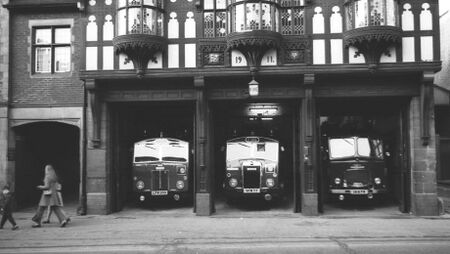
The council bought the land off the west side of Northgate Street on which the fire station stood in 1900, and completed a new station, designed by James Strong as a half-timbered building with three arched entrances, in 1911. This building can still be seen at Number 73 and is now "Chez Jules" a noted "French" Restaurant. Old cottages in Valentine's Court (now "Fireman's Square") behind the station were replaced in the 1920s with six firemen's cottages and a superintendent's house fronting Northgate Street. Firemen are sometimes superstitious and both the appliance room and the control room were said to be haunted by the bewhiskered "Fireman Jack" dressed in an old-fashioned Fireman's uniform complete with brass helmet:
- One night the Fireman manning the control room looked through the control room door's observation panel and said he saw Jack sitting on the old turntable ladder and smiling at him. He was so frightened that he immediately threw the bells on and turned out the watch. When the rest of the watch reached him they said he was white as a sheet.
Meanwhile in 1914 the city council's brigade was revived, consisting of a full-time superintendent and assistant, three sergeants and 18 firemen paid retaining fees, and an unpaid reserve, whereupon the Earl of Chester's Volunteers voluntarily disbanded. More full-time firemen were appointed in the 1920s and 1930s, starting with drivers, and the unpaid reserve was dispensed with in 1937.
The first motorized fire engine was bought in 1914. The following year they received a motor appliance made by John Morris and Co of Manchester. It cost £1070 and carried a 50ft wheeled escape and a 600gpm pump. The brigade began providing a service for rural areas outside the city boundary c. 1920, and by 1937 covered Hoole urban district and Tarvin rural district, and was about to make similar arrangements with the rural district councils of Hawarden and Chester; in 1939 a substation was established at Ellesmere Port. As a preparation for war an auxiliary fire service was set up in 1938. On the formation of the National Fire Service in 1941 Chester's brigade was taken over by a district which included Liverpool and Wirral, and the city council regained control of the force only in 1947. It was apparent early in the 1950s that the Northgate Street fire station was too small and difficult of access, but a new station was opened only in 1970, on the site of the Northgate railway station goods yard. Responsibility for fire services was transferred from the city to the county council in 1974 under the 1972 Local Government Act.
In 2019 Chester's fire appliances moved into a temporary station built in the rear yard of the St Anne Street station, after storage and other buildings were demolished along with the training tower. The 1970s fire station building was knocked down in early 2020.
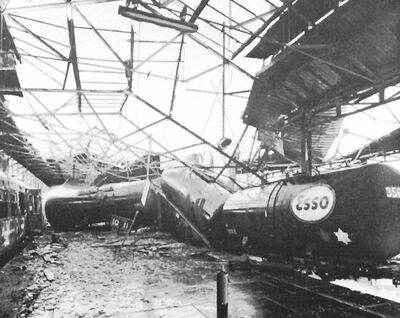
- 1140: Major fire in Chester.
- mcxlij kal. Julii urbs cestria combusta et castellum de Bromfeld v non. Martii. iij non. octobris obiit Willelmus abbas Cestrie cui successit Radulphus abbas xi kal. (Feb. - The city of Chester was burned down on June 30, and the castle of Bromfield on March 3).
- 1180: Major fire destroys much of Chester. The mint is closed.
- 1278: Great fire destroys "almost all the buildings within the City Walls".
- 1302: Fire in the Agricola Tower
- 1493: "great fire without the Northgate" (Roberts)
- 1500: another "great fire without the Northgate" (Roberts)
- 1564: "great fire without the Northgate" (Roberts)
- 1566: "great fire in Handbridge" (Roberts)
- 1767: 24th February, a disastrous fire broke out at the Roodee workhouse (at Portpool) used for spinning cotton. The building, which then housed 200 children in addition to the adults, was totally destroyed. The fatalities included sixty children, twelve men and five women — seventy-seven in all. A report in the London Chronicle recounted the horrifying scenes of inmates running naked from the building, while others jumped from windows and the roof. A party of thirty men was employed to dig out the bones and dead bodies but without success — it was assumed that they had all burnt to ashes
- 1805: Parry and Truss coachworks in Foregate Street burns down.
- 1809: The "Sugar House" in Cuppin Lane destroyed by fire
- 1811: Parry and Truss coachworks burns down (again).
- 1823: Parry's coach works burns down for the third time.
- 1824: Parry's coach works burns down for the fourth time since 1805.
- 1834: Frosts steam mill burns down.
- 1861: Queen Railway Hotel goes up in flames.
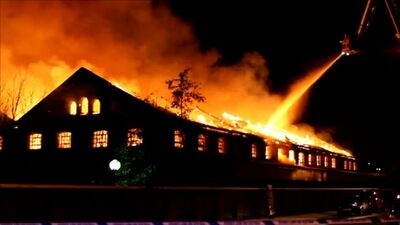
- 1878: "A fire broke out at Chester Castle on Monday evening, beneath the new court, which has recently been erected at a cost of £10,000. As soon as the flames were observed the men stationed at the Castle turned out and manned their engine. A window in the carpenter's store-room, in which the fire was raging, was broken, and volumes of water were poured in. The scene was exciting, for on one side the county prisoners were incarcerated, and on the other, in immediate proximity to Caesar's Tower, separated only from the burning building by a guard's box, immense quantities of ammunition are stored. To prevent the fire from extending to this tower, therefore, was the chief object of the men, as an explosion would have inevitably been terribly destructive to life and property. In a short time the firemen mastered the flames though the fire continued to burn for some time afterwards. The Chester fire brigade was unable to be present in time to render assistance, in consequence of a failure of the telegraphic apparatus. The storage of so large a quantity of ammunition in the city will forthwith be the subject of discussion in the Town Council" (The Times).
- 1972: The Chester General (Chester Station) Fire;
- 1985: County Stand at the Roodee consumed by fire;
- 1996: First Lightfoot Street Fire;
- 2002: Fire in Bridge Street (discussed in "Fire Safety in Historic Town Centers");
- 2008: A fire destroys much of the former Abbey Gate School in Victoria Road. It is made a listed building (later) in the same week.
- 2009: 17 July sixteen flats on Hoole Lane were destroyed following an explosion on the first floor. More than thirty firefighters tackled the resulting fire at the two-storey building in Wharton Court.
- 2010: Second Lightfoot Street Fire - Chester Enterprise Center burnt-out;
- 2016: June 19th, Hoole Bridge closed briefly as appliances extinguish a fire at a furniture store next to the bridge.
